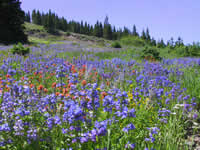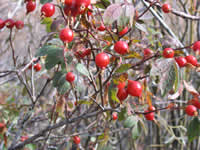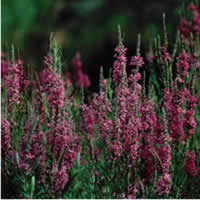 |
Basic Instructions for Restoration and Native Landscaping Projects

Photo by Teresa Prendusi.
Introduction
Going Native (with native plants) is EXCITING! There are a few key things to keep in mind when beginning to use native plants in restoration and landscaping projects. The State of Minnesota, Department of Natural Resources (© 2004, reprinted here with permission) has come up with the following suggestions or instructions.
- It takes time for native plants to get established. It’s important to know from the outset that it may take a few years for native plantings to look attractive. Prairie plants need a few years to establish strong roots. Trees and shrubs need time to get established and mature before they will flower and bear fruits. In time, plants will spread and propagate, creating patterns that work well in each space.
- Gain an understanding of the native plant communities in your area. Those plant communities occur there because they are adapted to the specific climate, landscape, and soil conditions. You can obtain information about the vegetation in your part of Minnesota at the time of the Public Land Survey from the Minnesota DNR. By visiting existing natural areas in your community or region, you can see for yourself what the native vegetation is like.
- Understand local government regulations affecting the use and ongoing management of natural landscaping. Regulations may affect the location of natural landscaping on the site and the types of plants used. You may need to know local weed ordinances and fire regulations before proceeding.
- Get to know your site. Many factors determine what kinds of site preparation will be needed and which species should be used, such as:
- Existing plants. You may already have native plants that are desirable for that site, such as prairie plants in a pasture, or native trees. Be sure you are not removing desirable native plants that are already well adapted to a site.
- Sun exposure. How much sun is there, and how long is the site exposed to sunlight?
- Soil type. Is soil sandy, clay, loam, or peat? Consult your county soil atlas. To learn soil acidity (ph) and organic content, get a soil test from a local University of Minnesota Extension Office or Soil and Water Conservation District. Also note that in urban areas, there may be fill on the site.
- Drainage and soil moisture. Does the soil hold moisture? Is it dry, mesic (rain soaks in with low run-off), or wet?

Photo by Scott Loken.
- Look at neighboring natural vegetation. Determine whether your planting will negatively influence wild native plants, or be influenced by nearby weedy exotics. Plan your native planting to harmonize with adjacent areas as much as possible.
- Consider your budget. The cost of using native plants for landscaping is often lower than the cost of using non-native plants when factored over a period of time. A native planting is a long-term investment; it can be built in phases. It is important to plan according to how much money and time you have now and in the future.
- Money may be needed for site preparation, plant materials, and maintenance.
- Budget your time and resources. You can choose to do site preparation yourself or hire a contractor. You may be able to gather seed, or may need to buy seed or plants.
- Consider these options based on available money:
- Plant the entire site with many different species
- Plant the entire site with a few species, and add more diversity as budget allows
- Plant many species on a part of the site, then use your own resulting seeds and seedlings to expand the planted area
- Create a wish list of species for your site. Visit natural areas to learn how local native species grow in a plant community setting, and consult planting and identification guides.

Photo by Kim Pierson.
Diverse plantings that resemble the native plant community in your area are likely to have the most success and confer the most benefits. To help you choose species, some producers provide guides or species lists which include each plant's site requirements, bloom color and bloom time. For east-central Minnesota, look for native plant community species lists at the Great River Greening website. A good resource for shoreland restoration is the "Restore Your Shore" Interactive CD-ROM.
- Shop for native plant materials. Look for sources selling seeds and plants produced from seeds of local origin.
- For seeds, the highest success usually comes from using cleaned local origin seed with a high percentage of pure live seed (PLS).
- Make sure plants are not dug from the wild. This depletes the resource and many species do not thrive after transplanting.
- Prepare and plant the site.
- Do you have proper planting equipment? For prairie seeds, ask seed producers about a Truax drill for large sites and hand operated seeders for small sites. Broadcasting prairie seeds by hand is often a viable option and may result in more natural planting patterns.
- Is existing vegetation relatively weed free? If so, consider inter-seeding (no till) or plugging plants into existing vegetation in places such as thin lawns, or sparsely vegetated old fields. This can result in fewer new weeds.
- Are there noxious weeds or problem species that will compete with native species? Seek competent advice on control techniques and eliminate before planting natives.
- Some alternatives include careful use of herbicides, hand pulling, using weed wrenches, cultivation or mowing. The booklet Minnesota Invasive Non-native Terrestrial Plants; An Identification Guide for Resource Managers is a good resource.
- Manage your site. "Low maintenance" does not mean "no maintenance." The first few growing seasons especially require maintenance. Develop a plan that takes these factors into account:

Purple loosestrife - beautiful but
invasive.
- Plan for weed control. There are a variety of weed control methods. Find the one that best suits your situation. In early plantings, mulch can help choke weeds and support seedlings. In prairie/savanna plantings, plan to mow before weeds reach 6-12 inches.
- When possible, for those plant communities naturally maintained by fire such as prairies, savannas, and many pine forests, conduct safe controlled burns when there is enough fuel to achieve a thorough burn. If burning is not possible, plan to mow and remove clippings.
- For trees and forest plantings, weed control and protection from wildlife is often necessary for small seedlings.
|
U.S. Forest Service
Rangeland Management
Botany Program
1400 Independence Ave., SW, Mailstop Code: 1103
Washington DC 20250-1103

|



